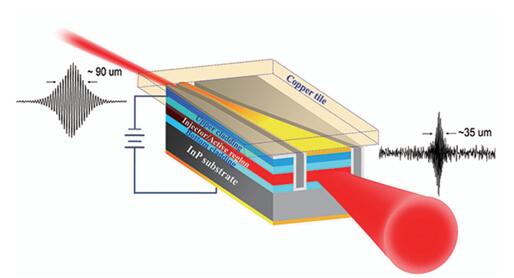Semiconductor broadband light emitters have emerged as ideal and vital light sources for a range of biomedical sensing/imaging applications, especially for optical coherence tomography systems. Although near-infrared broadband light emitters have found increasingly wide utilization in these imaging applications, the requirement to simultaneously achieve both a high spectral bandwidth and output power is still challenging for such devices. Due to the relatively weak amplified spontaneous emission, as a consequence of the very short non-radiative carrier lifetime of the inter-subband transitions in quantum cascade structures, it is even more challenging to obtain desirable mid-infrared broadband light emitters.
There have been great efforts in the past twenty years to pursue high-efficiency broadband optical gain and very low reflectivity in waveguide structures, which are two key factors determining the performance of broadband light emitters. Recently, Prof. ZHANG Ziyang from Suzhou Institute of Nano-Tech and Nano-Bionics, Chinese Academy of Sciences, and Prof. LIU Fengqi and Prof. WANG Zhanguo from Institute of Semiconductor, Chinese Academy of Sciences, had made an important progress on the research area of infrared broadband light sources.
As seen in Figure 1, they have realized a high continuous wave light power of >20 mW and broadband width of >130 nm near-infrared broadband light emitters by employing a modulation p-doped InGaAs/GaAs quantum dot active region with a "J" shape ridge waveguide structure. Then, as shown in Figure 2, the first mid-infrared broadband light emitters operating under continuous wave mode at room temperature has been demonstrated by utilizing a quantum cascade active region with a dual-end analogous monolithic integrated tapered waveguide structure.
This work is of great importance to improve the performance of existing near-infrared optical coherence tomography systems and describes a major advance toward reliable and cost-effective mid-infrared imaging and sensing systems, which do not presently exist due to the lack of appropriate low-coherence mid-infrared semiconductor broadband light sources.

Figure 1. Schematic device diagrams of the "J"-shaped quantum dot broadband light emitter.(Image by SINANO)

Figure 2. Schematic diagram of the two simultaneous incoherent light emissions in the MIR quantum cascade broadband light emitter.(Image by SINANO)
Contact information:
Prof.ZHANG Ziyang,Suzhou institute of Nano-Tech and Nano-Bionics, Chinese Academy of Sciences.
Email: zyzhang2014@sinano.ac.cn
Reference: https://www.nature.com/articles/lsa2017170

